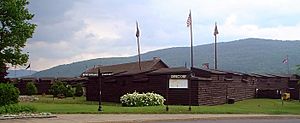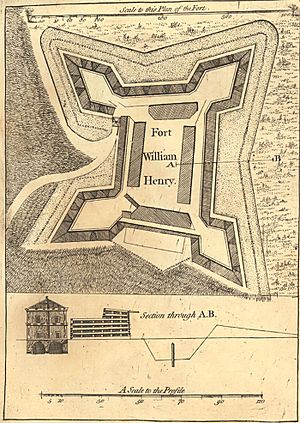Fort William Henry facts for kids
Quick facts for kids Fort William Henry |
|
|---|---|
 |
|
| Type | Fort |
| Site information | |
| Controlled by | |
| Site history | |
| Built | 1755 |
| In use | 1755–1757 |
| Battles/wars | French and Indian War |
Fort William Henry was an important British fort. It was located at the southern end of Lake George in the province of New York. The fort was built in 1755 during the French and Indian War.
Sir William Johnson ordered its construction. The fort was meant to be a starting point for attacks against the French at Fort St. Frédéric. It was a key spot along a waterway connecting New York City to Montreal.
In 1757, the French general Louis-Joseph de Montcalm led a successful attack on the fort. The British soldiers had to surrender. After the surrender, some Huron warriors, who were with the French army, attacked and killed many British prisoners. This event is famously shown in James Fenimore Cooper's book The Last of the Mohicans.
The fort was named after two British princes: Prince William and Prince William Henry. After the 1757 attack, the French destroyed the fort. The site was empty for 200 years. In the 1950s, a copy of the fort was built. Today, it is a museum and a popular place to visit in the village of Lake George.
Contents
Building the Fort
In 1755, Sir William Johnson set up a military camp. This was at the southern end of Lake George. His goal was to attack Fort St. Frédéric, a French fort. This French fort was at Crown Point on Lake Champlain.
The French commander, Baron Dieskau, decided to attack Johnson's supply base first. This base was at Fort Edward on the Hudson River. Their movements led to the Battle of Lake George on September 8, 1755. Part of this battle happened where Johnson's camp was.
After the battle, Johnson decided to build a fort there. At the same time, the French started building Fort Carillon at the northern end of the lake.
Fort Design and Features
A British engineer named William Eyre designed and built Fort William Henry. It was an irregular square shape. It had strong corners called bastions. The design was good for stopping attacks from Native Americans. However, it was not built to withstand attacks from enemies with heavy cannons.
The fort's walls were about 30 feet (9 meters) thick. They had logs on the outside and were filled with earth. Inside the fort, there were two-story wooden buildings. These were for soldiers to live in.
The fort had a special room for gunpowder in one corner. This was called a magazine. There was also a hospital in another corner. Three sides of the fort had a dry moat around them. The fourth side sloped down to the lake. The only way into the fort was over a bridge that crossed the moat.
The fort could hold 400 to 500 soldiers. More troops stayed in a camp about 750 yards (685 meters) southeast of the fort. This was near where the 1755 Battle of Lake George happened.
Life at the Fort
Fort William Henry was ready for soldiers by November 13, 1755. William Eyre was its first commander. The fort was guarded by soldiers from his 44th regiment. Some companies of Rogers' Rangers were also there.
In the spring of 1757, George Monro took command of the fort. Most of his soldiers were from the 35th and 60th regiments. By June, about 1,600 soldiers were at the fort. These included local soldiers from Connecticut and New Jersey.
The fort was too small for all these soldiers. So, many of them stayed in Johnson's old camp. In late July, news came that the French were planning an attack. Another 1,000 soldiers arrived. This made Monro's force about 2,300 strong. The camp where many soldiers stayed was quickly protected with trenches. Life in the fort and camp was hard. Many soldiers got sick, some even with smallpox.
The Siege of 1757
The French army, led by General Louis-Joseph de Montcalm, arrived on August 3, 1757. They set up camps south and west of the fort. The French force was very large. It had about 8,000 people. This included 3,000 regular soldiers, 3,000 local soldiers, and nearly 2,000 Native Americans from different tribes.
The French attacked the fort with heavy cannons. They slowly moved closer to the fort's walls. It became clear that General Daniel Webb, who was at Fort Edward, was not sending help. So, the British soldiers surrendered on August 8. They were allowed to keep their flags and unloaded muskets. They could also keep one cannon as a symbol.
The British soldiers were allowed to march to Fort Edward. French soldiers would go with them to protect them. They agreed not to fight in the war again until they were officially exchanged for French prisoners. The British also promised to release French prisoners within three months.
After the Surrender
Montcalm tried to make sure his Native American allies understood the surrender terms. But the Native Americans began taking things from the fort right away. The next morning, they attacked the British soldiers again before they could leave.
As the British marched away, the Native Americans bothered them. They tried to take their weapons and clothes. When the last soldiers left the camp, a war cry sounded. Warriors grabbed some men at the back of the line. At this point, the column of soldiers broke apart. Some prisoners tried to run away. Others tried to defend themselves.
Montcalm and other French officers tried to stop these attacks. But some French officers did not help. It is hard to know exactly how many British soldiers were captured, hurt, or killed. Estimates have varied a lot. However, detailed studies suggest that between 69 and 184 soldiers were missing or dead. This was about 7.5% of the 2,308 soldiers who surrendered.
The Native Americans killed soldiers who were inside the fort. They also killed unarmed British soldiers whom the French had allowed to leave. The victims included African Americans and Native Americans who had sided with the British.
Fort Abandoned and Rebuilt
After the siege, the French completely destroyed Fort William Henry. Then they went back to Fort Carillon. The site of Fort William Henry was left empty for 200 years.
In the 1950s, a copy of the fort was built. This replica is now a museum. During the making of the 1992 movie The Last of the Mohicans, a large copy of Fort William Henry was built. This was done on Lake James in western North Carolina.
See also
 In Spanish: Fuerte William Henry para niños
In Spanish: Fuerte William Henry para niños



